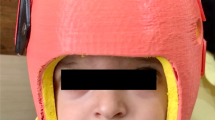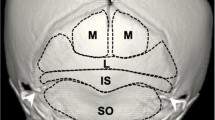Abstract
Purpose
To investigate the incidence of persistent, open metopic sutures in contemporary Australians aged 24 months and older.
Methods
Metopic suture evaluation was conducted on retrospective cranial/cervical computed tomography scans of patients aged 24 to 252 months who presented to the Women’s and Children’s Hospital in Adelaide, Australia, between 2010 and 2020. Suture ossification was graded according to Lottering scoring system based on 4 stages, on three-dimensional volume-rendered reconstructions (stage 1: fibrous tissue interface, stage 2: commenced fusion, stage 3: complete fusion and stage 4: obliterated suture). The complete persistent sutures were classified as stage 1. Partially closed sutures were classified into stages 2 and 3, while completely closed sutures were defined as stage 4.
Results
One thousand thirty-four patients (61.2% male and 38.8% female) were included, with a mean age at scan of 66 months. More than half of patients were subject to scanning due to closed-head injuries. The incidence of persistent (completely open) metopic suture was 4.8% (2.3% in males and 2.5% in females). In comparison, a partially closed metopic suture was found in 6.3% of the study cohort, with the remaining sutures located along the metopic suture line, at the glabella, mid-part of the suture, bregma and glabella-bregma areas.
Conclusion
The prevalence of persistent metopic sutures in our study of the Australian population is 4.8%, and it is equally distributed between the genders. The pattern of suture closure can commence from any location along the suture line, which is in contrast to the existing literature.






Similar content being viewed by others
References
Albin RE, Hendee RW Jr, O’Donnell RS, Majure JA (1985) Trigonocephaly: refinements in reconstruction. Experience with 33 patients. Plast Reconstr Surg 76(2):202–211
Cohen MM Jr (1993) Sutural biology and the correlates of craniosynostosis. Am J Med Genet 47(5):581–616. https://doi.org/10.1002/ajmg.1320470507
Fearon JA, Kolar JC, Munro IR (1996) Trigonocephaly-associated hypotelorism: is treatment necessary? Plast Reconstr Surg 97(3):503–511. https://doi.org/10.1097/00006534-199603000-00001
Vu HL, Panchal J, Parker EE, Levine NS, Francel P (2001) The timing of physiologic closure of the metopic suture: a review of 159 patients using reconstructed 3D CT scans of the craniofacial region. J Craniofac Surg 12(6):527–532. https://doi.org/10.1097/00001665-200111000-00005
Vinchon M (2019) The metopic suture: natural history. Neurochirurgie 65(5):239–245. https://doi.org/10.1016/j.neuchi.2019.09.006
Lottering N, MacGregor DM, Alston CL, Watson D, Gregory LS (2016) introducing computed tomography standards for age estimation of modern Australian subadults using postnatal ossification timings of select cranial and cervical sites (.). J Forensic Sci 61(Suppl 1):S39–S52. https://doi.org/10.1111/1556-4029.12956
Teager SJ, Constantine S, Lottering N, Anderson PJ (2019) Physiologic closure time of the metopic suture in South Australian infants from 3D CT scans. Childs Nerv Syst 35(2):329–335. https://doi.org/10.1007/s00381-018-3957-9
Ashley-Montagu M (1937) The medio-frontal suture and the problem of metopism in the primates. J Roy Anthrop Inst Great Britain Ireland 67:157–201
Zdilla MJ, Russell ML, Koons AW, Bliss KN, Mangus KR (2018) Metopism: a study of the persistent metopic suture. J Craniofac Surg 29(1):204–208. https://doi.org/10.1097/SCS.0000000000004030
Anutschin D (1883) De la suture medio-frontale chez l’adulte, dans les races humaines. Analysis In Rev d’Anthrop 358–362
da Silva IN, Fernandes KJ, Ramalho AJ, Bispo RF, Rodrigues CF, Aragão JA (2013) Occurrence of metopism in dry crania of adult brazilians. ISRN Anat 2013:158341. https://doi.org/10.5402/2013/158341
Singh S, Suman P, Panigrahi AK (2017) Morphological variation and occurrence of persistent metopic suture in Indian population. Natl J Basic Med Sci 8(2):77–82
Baaten PJ, Haddad M, Abi-Nader K, Abi-Ghosn A, Al-Kutoubi A, Jurjus AR (2003) Incidence of metopism in the Lebanese population. Clin Anat 16(2):148–151. https://doi.org/10.1002/ca.10050
Çalışkan S, Oğuz KK, Tunalı S, Aldur MM, Erçakmak B, Sargon MF (2018) Morphology of cranial sutures and radiologic evaluation of the variations of intersutural bones. Folia Morphol (Warsz) 77(4):730–735. https://doi.org/10.5603/FM.a2018.0030
Jk WOO (1949) Racial and sexual differences in the frontal curvature and its relation to metopism. Am J Phys Anthropol 7(2):215–226. https://doi.org/10.1002/ajpa.1330070205
Ajmani ML, Mittal RK, Jain SP (1983) Incidence of the metopic suture in adult Nigerian skulls. J Anat 137:177–183
Opperman LA (2000) Cranial sutures as intramembranous bone growth sites. Dev Dyn 219(4):472–485. https://doi.org/10.1002/1097-0177(2000)9999:9999%3c::AID-DVDY1073%3e3.0.CO;2-F
Manzanares MC, Goret-Nicaise M, Dhem A (1988) Metopic sutural closure in the human skull. J Anat 161:203–215
Coussens AK, Wilkinson CR, Hughes IP et al (2007) Unravelling the molecular control of calvarial suture fusion in children with craniosynostosis. BMC Genomics 8:458. https://doi.org/10.1186/1471-2164-8-458
Karabagli P (2013) Pathology in metopic synostosis. Childs Nerv Syst 29(12):2165–2170. https://doi.org/10.1007/s00381-013-2284-4
Opperman LA, Passarelli RW, Nolen AA et al (1996) Dura mater secretes soluble heparin-binding factors required for cranial suture morphogenesis. In Vitro Cell Dev Biol 32:627–632
Bradley JP, Levine JP, Blewett C, Krummel T, McCarthy JG, Longaker MT (1996) Studies in cranial suture biology: in vitro cranial suture fusion. Cleft Palate Craniofac J 33(2):150–156. https://doi.org/10.1597/1545-1569_1996_033_0150_sicsbv_2.3.co_2
Levine JP, Bradley JP, Roth DA, McCarthy JG, Longaker MT (1998) Studies in cranial suture biology: regional dura mater determines overlying suture biology. Plast Reconstr Surg 101(6):1441–1447. https://doi.org/10.1097/00006534-199805000-00002
Vissers LE, Cox TC, Maga AM et al (2011) Heterozygous mutations of FREM1 are associated with an increased risk of isolated metopic craniosynostosis in humans and mice. PLoS Genet 7(9):e1002278. https://doi.org/10.1371/journal.pgen.1002278
Bradley JP, Levine JP, Roth DA, McCarthy JG, Longaker MT (1996) Studies in cranial suture biology: IV Temporal sequence of posterior frontal cranial suture fusion in the mouse. Plast Reconstr Surg 98(6):1039–1045. https://doi.org/10.1097/00006534-199611000-00018
Faro C, Benoit B, Wegrzyn P, Chaoui R, Nicolaides KH (2005) Three-dimensional sonographic description of the fetal frontal bones and metopic suture. Ultrasound Obstet Gynecol 26(6):618–621. https://doi.org/10.1002/uog.1997
Author information
Authors and Affiliations
Contributions
Sarut Chaisrisawadisuk: conception and design, collection and assembly of data, data analysis, manuscript writing. Sarah Constantine: conception and design, collection and assembly of data, data analysis. Nicolene Lottering: conception and design, collection and assembly of data, manuscript writing. Mark H. Moore: conception and design, manuscript writing. Peter J. Anderson: conception and design, data analysis, final approval of manuscript.
Corresponding author
Ethics declarations
Ethics approval
The study was approved by the Institutional Review Board of the Women’s and Children’s Health Network Human Research Ethics Committee (Audit 838A).
Conflict of interest
The authors report that there are no conflicts of interest related to the present work.
Additional information
Publisher's Note
Springer Nature remains neutral with regard to jurisdictional claims in published maps and institutional affiliations.
Rights and permissions
About this article
Cite this article
Chaisrisawadisuk, S., Constantine, S., Lottering, N. et al. Incidence of persistent metopic suture in Australia: findings from 1034 three-dimensional computed tomography scans. Childs Nerv Syst 37, 3871–3879 (2021). https://doi.org/10.1007/s00381-021-05313-6
Received:
Accepted:
Published:
Issue Date:
DOI: https://doi.org/10.1007/s00381-021-05313-6




